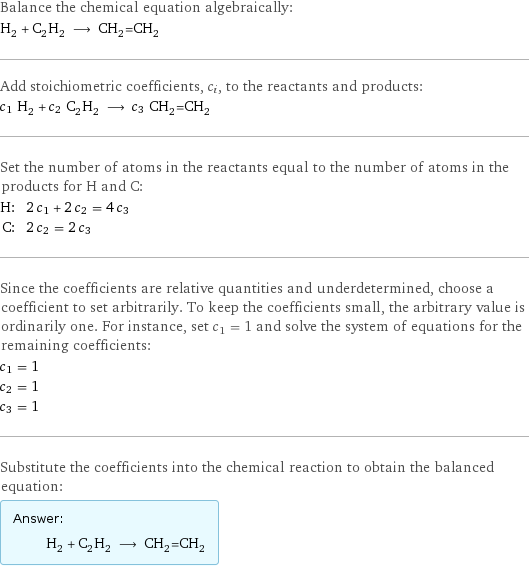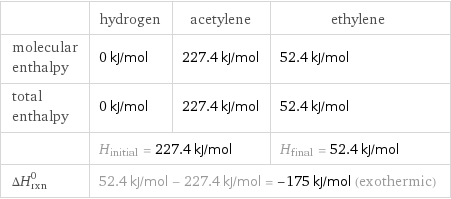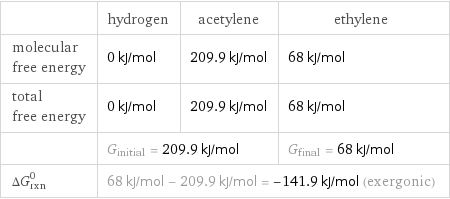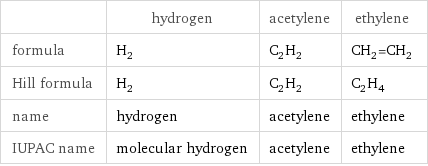Input interpretation

H_2 hydrogen + C_2H_2 acetylene ⟶ CH_2=CH_2 ethylene
Balanced equation

Balance the chemical equation algebraically: H_2 + C_2H_2 ⟶ CH_2=CH_2 Add stoichiometric coefficients, c_i, to the reactants and products: c_1 H_2 + c_2 C_2H_2 ⟶ c_3 CH_2=CH_2 Set the number of atoms in the reactants equal to the number of atoms in the products for H and C: H: | 2 c_1 + 2 c_2 = 4 c_3 C: | 2 c_2 = 2 c_3 Since the coefficients are relative quantities and underdetermined, choose a coefficient to set arbitrarily. To keep the coefficients small, the arbitrary value is ordinarily one. For instance, set c_1 = 1 and solve the system of equations for the remaining coefficients: c_1 = 1 c_2 = 1 c_3 = 1 Substitute the coefficients into the chemical reaction to obtain the balanced equation: Answer: | | H_2 + C_2H_2 ⟶ CH_2=CH_2
Structures

+ ⟶
Names

hydrogen + acetylene ⟶ ethylene
Reaction thermodynamics
Enthalpy

| hydrogen | acetylene | ethylene molecular enthalpy | 0 kJ/mol | 227.4 kJ/mol | 52.4 kJ/mol total enthalpy | 0 kJ/mol | 227.4 kJ/mol | 52.4 kJ/mol | H_initial = 227.4 kJ/mol | | H_final = 52.4 kJ/mol ΔH_rxn^0 | 52.4 kJ/mol - 227.4 kJ/mol = -175 kJ/mol (exothermic) | |
Gibbs free energy

| hydrogen | acetylene | ethylene molecular free energy | 0 kJ/mol | 209.9 kJ/mol | 68 kJ/mol total free energy | 0 kJ/mol | 209.9 kJ/mol | 68 kJ/mol | G_initial = 209.9 kJ/mol | | G_final = 68 kJ/mol ΔG_rxn^0 | 68 kJ/mol - 209.9 kJ/mol = -141.9 kJ/mol (exergonic) | |
Entropy

| hydrogen | acetylene | ethylene molecular entropy | 115 J/(mol K) | 201 J/(mol K) | 219 J/(mol K) total entropy | 115 J/(mol K) | 201 J/(mol K) | 219 J/(mol K) | S_initial = 316 J/(mol K) | | S_final = 219 J/(mol K) ΔS_rxn^0 | 219 J/(mol K) - 316 J/(mol K) = -97 J/(mol K) (exoentropic) | |
Equilibrium constant
![Construct the equilibrium constant, K, expression for: H_2 + C_2H_2 ⟶ CH_2=CH_2 Plan: • Balance the chemical equation. • Determine the stoichiometric numbers. • Assemble the activity expression for each chemical species. • Use the activity expressions to build the equilibrium constant expression. Write the balanced chemical equation: H_2 + C_2H_2 ⟶ CH_2=CH_2 Assign stoichiometric numbers, ν_i, using the stoichiometric coefficients, c_i, from the balanced chemical equation in the following manner: ν_i = -c_i for reactants and ν_i = c_i for products: chemical species | c_i | ν_i H_2 | 1 | -1 C_2H_2 | 1 | -1 CH_2=CH_2 | 1 | 1 Assemble the activity expressions accounting for the state of matter and ν_i: chemical species | c_i | ν_i | activity expression H_2 | 1 | -1 | ([H2])^(-1) C_2H_2 | 1 | -1 | ([C2H2])^(-1) CH_2=CH_2 | 1 | 1 | [CH2=CH2] The equilibrium constant symbol in the concentration basis is: K_c Mulitply the activity expressions to arrive at the K_c expression: Answer: | | K_c = ([H2])^(-1) ([C2H2])^(-1) [CH2=CH2] = ([CH2=CH2])/([H2] [C2H2])](../image_source/a768b604ac98bb2c90ccd9d9c8632236.png)
Construct the equilibrium constant, K, expression for: H_2 + C_2H_2 ⟶ CH_2=CH_2 Plan: • Balance the chemical equation. • Determine the stoichiometric numbers. • Assemble the activity expression for each chemical species. • Use the activity expressions to build the equilibrium constant expression. Write the balanced chemical equation: H_2 + C_2H_2 ⟶ CH_2=CH_2 Assign stoichiometric numbers, ν_i, using the stoichiometric coefficients, c_i, from the balanced chemical equation in the following manner: ν_i = -c_i for reactants and ν_i = c_i for products: chemical species | c_i | ν_i H_2 | 1 | -1 C_2H_2 | 1 | -1 CH_2=CH_2 | 1 | 1 Assemble the activity expressions accounting for the state of matter and ν_i: chemical species | c_i | ν_i | activity expression H_2 | 1 | -1 | ([H2])^(-1) C_2H_2 | 1 | -1 | ([C2H2])^(-1) CH_2=CH_2 | 1 | 1 | [CH2=CH2] The equilibrium constant symbol in the concentration basis is: K_c Mulitply the activity expressions to arrive at the K_c expression: Answer: | | K_c = ([H2])^(-1) ([C2H2])^(-1) [CH2=CH2] = ([CH2=CH2])/([H2] [C2H2])
Rate of reaction
![Construct the rate of reaction expression for: H_2 + C_2H_2 ⟶ CH_2=CH_2 Plan: • Balance the chemical equation. • Determine the stoichiometric numbers. • Assemble the rate term for each chemical species. • Write the rate of reaction expression. Write the balanced chemical equation: H_2 + C_2H_2 ⟶ CH_2=CH_2 Assign stoichiometric numbers, ν_i, using the stoichiometric coefficients, c_i, from the balanced chemical equation in the following manner: ν_i = -c_i for reactants and ν_i = c_i for products: chemical species | c_i | ν_i H_2 | 1 | -1 C_2H_2 | 1 | -1 CH_2=CH_2 | 1 | 1 The rate term for each chemical species, B_i, is 1/ν_i(Δ[B_i])/(Δt) where [B_i] is the amount concentration and t is time: chemical species | c_i | ν_i | rate term H_2 | 1 | -1 | -(Δ[H2])/(Δt) C_2H_2 | 1 | -1 | -(Δ[C2H2])/(Δt) CH_2=CH_2 | 1 | 1 | (Δ[CH2=CH2])/(Δt) (for infinitesimal rate of change, replace Δ with d) Set the rate terms equal to each other to arrive at the rate expression: Answer: | | rate = -(Δ[H2])/(Δt) = -(Δ[C2H2])/(Δt) = (Δ[CH2=CH2])/(Δt) (assuming constant volume and no accumulation of intermediates or side products)](../image_source/8f2a66bdb22b9dda00ff2610770aee36.png)
Construct the rate of reaction expression for: H_2 + C_2H_2 ⟶ CH_2=CH_2 Plan: • Balance the chemical equation. • Determine the stoichiometric numbers. • Assemble the rate term for each chemical species. • Write the rate of reaction expression. Write the balanced chemical equation: H_2 + C_2H_2 ⟶ CH_2=CH_2 Assign stoichiometric numbers, ν_i, using the stoichiometric coefficients, c_i, from the balanced chemical equation in the following manner: ν_i = -c_i for reactants and ν_i = c_i for products: chemical species | c_i | ν_i H_2 | 1 | -1 C_2H_2 | 1 | -1 CH_2=CH_2 | 1 | 1 The rate term for each chemical species, B_i, is 1/ν_i(Δ[B_i])/(Δt) where [B_i] is the amount concentration and t is time: chemical species | c_i | ν_i | rate term H_2 | 1 | -1 | -(Δ[H2])/(Δt) C_2H_2 | 1 | -1 | -(Δ[C2H2])/(Δt) CH_2=CH_2 | 1 | 1 | (Δ[CH2=CH2])/(Δt) (for infinitesimal rate of change, replace Δ with d) Set the rate terms equal to each other to arrive at the rate expression: Answer: | | rate = -(Δ[H2])/(Δt) = -(Δ[C2H2])/(Δt) = (Δ[CH2=CH2])/(Δt) (assuming constant volume and no accumulation of intermediates or side products)
Chemical names and formulas

| hydrogen | acetylene | ethylene formula | H_2 | C_2H_2 | CH_2=CH_2 Hill formula | H_2 | C_2H_2 | C_2H_4 name | hydrogen | acetylene | ethylene IUPAC name | molecular hydrogen | acetylene | ethylene